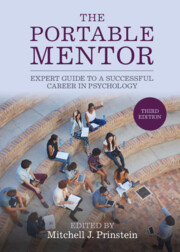Book contents
- The Portable Mentor
- The Portable Mentor
- Copyright page
- Dedication
- Contents
- Figures
- Tables
- Boxes
- Contributors
- Preface
- Acknowledgments
- Part I Applying to Graduate School
- Part II Beginning your Career
- Part III Your Research/Academic Career
- Part IV Your Career as a Practitioner
- Part V Your Professional Service Career
- Part VI Your Career After Graduate School
- 25 Recommendations for a Postdoctoral Fellowship
- 26 Career Versatility in Employment Trends
- 27 Career Possibilities with your Doctorate in Psychology: Stories from Inspiring Leaders
- 28 Professional Women in Psychology: Integrating Your Values into a Full Life
- 29 The Job Search
- 30 Balancing Career and Family
- Index
- References
30 - Balancing Career and Family
from Part VI - Your Career After Graduate School
Published online by Cambridge University Press: 21 July 2022
- The Portable Mentor
- The Portable Mentor
- Copyright page
- Dedication
- Contents
- Figures
- Tables
- Boxes
- Contributors
- Preface
- Acknowledgments
- Part I Applying to Graduate School
- Part II Beginning your Career
- Part III Your Research/Academic Career
- Part IV Your Career as a Practitioner
- Part V Your Professional Service Career
- Part VI Your Career After Graduate School
- 25 Recommendations for a Postdoctoral Fellowship
- 26 Career Versatility in Employment Trends
- 27 Career Possibilities with your Doctorate in Psychology: Stories from Inspiring Leaders
- 28 Professional Women in Psychology: Integrating Your Values into a Full Life
- 29 The Job Search
- 30 Balancing Career and Family
- Index
- References
Summary
This chapter describes the process of acquiring a job in psychology.It reviews the kinds of jobs available in psychology, ranging from jobs in psychology departments, to jobs in education departments, medical schools, business schools, and other academic units.It also describes non-academic job opportunities in business, nonprofits, and government agencies. The chapter details the steps one typically goes through in acquiring a job, such as preparing a CV (vita), a job application letter, and a statement of purpose.Job applicants typically also go through some kind of job interview and need to seek letters of recommendation that will show that they are not only appropriate for the job, but also that they will excel at it.The chapter is full of tips for how to maximize one’s success on the job market.
- Type
- Chapter
- Information
- The Portable MentorExpert Guide to a Successful Career in Psychology, pp. 565 - 577Publisher: Cambridge University PressPrint publication year: 2022



